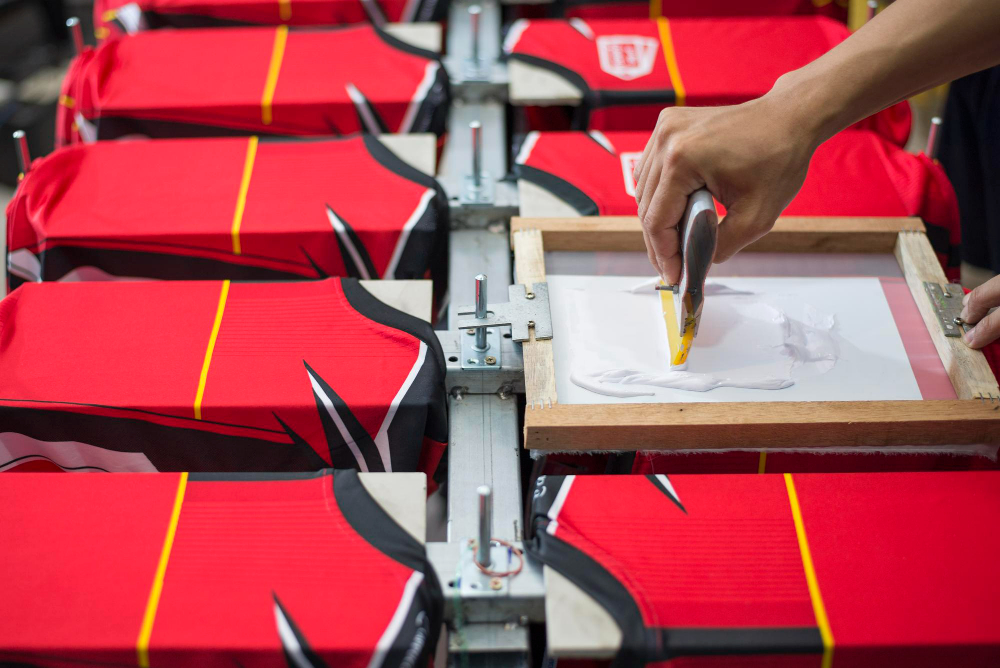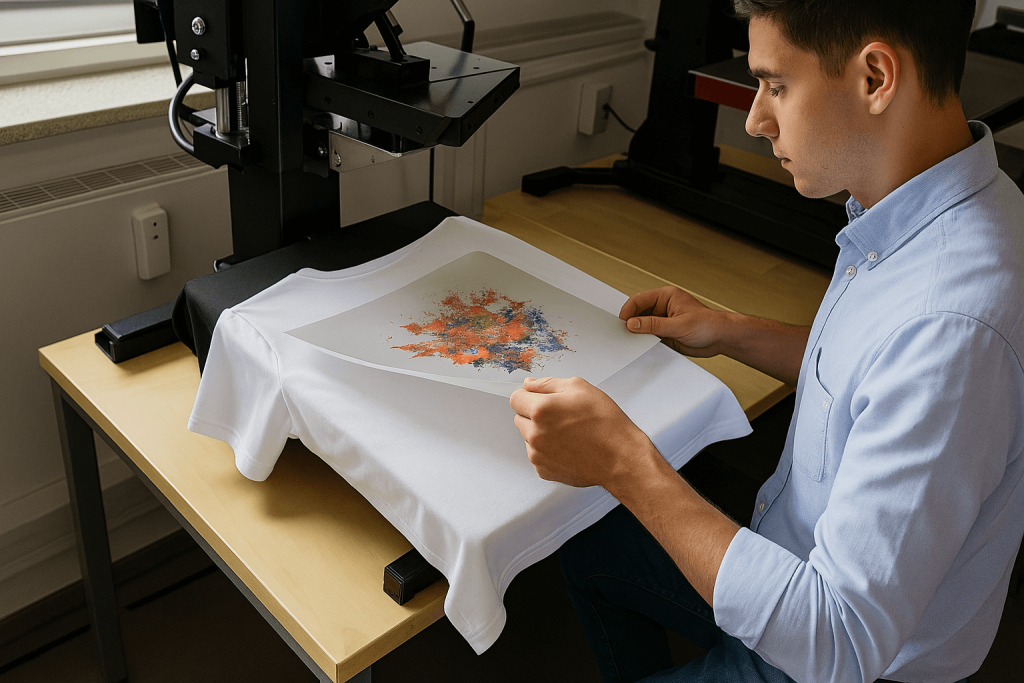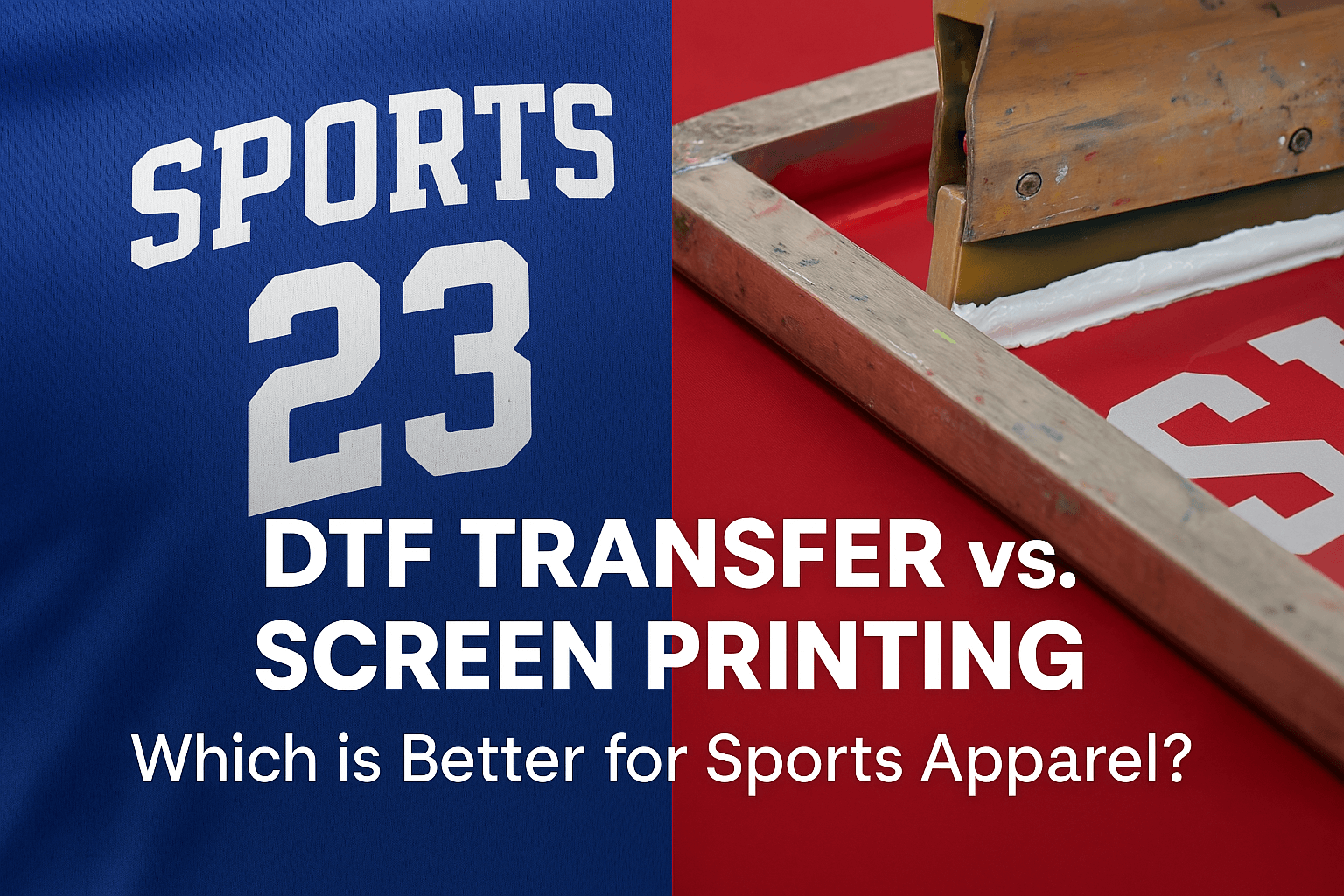When it comes to creating custom sports apparel, two printing methods dominate the scene: DTF transfer and screen printing. Each has its strengths and weaknesses, making it essential to understand the differences to determine which is better for your specific needs. In this post, we’ll compare DTF transfer and screen printing to help you decide which one works best for your teamwear designs.
What is DTF Transfer?
DTF (Direct-to-Film) transfer printing is a modern technique where designs are printed onto a special film and then transferred onto fabric using heat. This method allows for detailed and vibrant prints, which makes it a popular choice for custom apparel.
Key Features of DTF Transfer
- Detailed Designs: DTF transfer allows for intricate designs, including gradients and fine details, which can be difficult to achieve with other methods.
- Versatility: It works on a wide range of fabrics, including polyester, cotton, and blends, which is perfect for the different materials used in sports uniforms.
- Lower Setup Costs: Setting up DTF printing is more affordable, especially for small runs. This makes it a good choice for custom sports apparel that requires fewer units.
What is Screen Printing?
Screen printing, also known as silkscreen printing, is a traditional printing method where ink is applied to a fabric through a stencil or screen. This method is known for its vibrant colors and durability, making it a popular choice for large runs of custom apparel.

Key Features of Screen Printing
- Durability: Screen printing is known for producing long-lasting prints that can withstand numerous washes. This makes it a good option for sports teams that require uniforms that will hold up over time.
- Cost-Effective for Large Runs: While screen printing requires a more significant initial setup cost, it becomes more cost-effective when producing large volumes of apparel.
- Color Accuracy: Screen printing is great for designs with solid colors and works well for designs that require consistent, high-quality color application.
DTF Transfer vs. Screen Printing: The Key Differences
When comparing DTF transfer to screen printing, there are several factors to consider, such as cost, durability, color range, and production speed. Let’s break down how each method performs in these areas:
Cost Efficiency
- DTF Transfer: The setup costs for DTF printing are generally much lower compared to screen printing, making it ideal for small orders or custom designs. DTF is especially cost-effective for custom sports apparel in smaller quantities, as it doesn’t require the same level of investment in equipment and materials as screen printing.
- Screen Printing: While screen printing is more cost-effective for large runs, it can be expensive for smaller orders due to high setup costs. This method requires the creation of screens for each design, making it less efficient for small-scale production.
Durability
- DTF Transfer: While DTF prints offer good durability, they are not as long-lasting as screen prints. DTF designs may start to fade after several washes, especially with heavy use. However, advances in technology are improving the longevity of DTF prints.
- Screen Printing: Screen printing is known for its superior durability, with designs that can withstand up to 50 more washes than DTF prints before fading. This makes it an excellent choice for sports apparel, which is often exposed to frequent washing and wear.
Production Speed
- DTF Transfer: One of the major advantages of DTF printing is its faster production time. DTF prints can be processed and transferred onto garments quickly, reducing the overall turnaround time for custom sports uniforms.
- Screen Printing: Screen printing can take longer, especially when producing smaller orders or designs with multiple colors. The process involves several steps, including screen preparation, which can slow down production speed.
Color Range and Detail
- DTF Transfer: DTF printing is excellent for designs with a wide range of colors, gradients, and intricate details. The digital nature of DTF printing allows for a broader color gamut and the ability to reproduce complex designs more easily.
- Screen Printing: Screen printing excels at solid colors and simple designs, but it can struggle with more complex patterns and color gradients. Multiple screens are required for designs with various colors, which can add to the production time.
Benefits of DTF Transfer for Custom Sports Apparel
DTF transfer printing has a growing presence in the custom apparel industry, and for good reason. Here are some of the key benefits it offers for sports uniforms:
- Flexibility in Materials: DTF printing works on a variety of fabrics, including popular options like polyester and cotton. This allows sports teams to select the best material for their uniforms without worrying about compatibility with the printing method.
- Eco-Friendly Option: DTF printing produces 40% less waste compared to traditional screen printing, making it a more environmentally friendly choice. As sustainability becomes an important concern in the sports apparel industry, this is an important factor for many companies.
- Lower Initial Investment: The equipment for DTF printing is typically less expensive than screen printing setups, making it an accessible option for small businesses or startups looking to offer custom sports apparel.
Advantages of Screen Printing for Custom Sports Apparel
While DTF transfer printing offers several advantages, screen printing still remains the dominant choice for custom sports apparel in many cases. Here are some of the key reasons why:
- Long-Lasting Prints: Screen printing’s durability makes it ideal for sports uniforms that need to stand up to heavy wear and frequent washing. The ink used in screen printing bonds more effectively with the fabric, ensuring long-lasting results.
- Cost-Effective for Large Orders: If you’re producing a large batch of custom sports uniforms, screen printing becomes much more cost-effective. Once the screens are prepared, it’s easy to produce a high volume of uniforms quickly and at a lower cost per unit.
- Vibrant Colors: Screen printing offers vibrant, opaque colors that stay true over time, which is perfect for teams that want their uniforms to stand out with bold designs.
When to Choose DTF Transfer for Sports Apparel
DTF transfer is a great choice for sports teams or businesses looking to create smaller quantities of custom apparel with complex designs or intricate details. If you need a fast turnaround and are printing on a variety of fabrics, DTF is a flexible and cost-effective option.
Best Use Cases for DTF:
- Small to medium-sized orders
- Complex designs with fine details or gradients
- Quick turnaround times
- Eco-conscious brands seeking lower waste production

When to Choose Screen Printing for Sports Apparel
Screen printing is the go-to method for large orders of sports apparel that require durability and long-lasting prints. If your team needs uniforms that can withstand frequent washing and heavy use, screen printing is the more reliable option.
Best Use Cases for Screen Printing:
- Large volume orders
- Designs with solid colors and simple patterns
- Sports uniforms that need to be durable and long-lasting
- Businesses seeking an affordable solution for mass production
Conclusion
Both DTF transfer and screen printing offer unique advantages for custom sports apparel, and the best choice depends on your specific needs. If you’re looking for fast production with intricate designs and flexibility in materials, DTF transfer might be the better option. On the other hand, if you need durable, vibrant prints for large orders, screen printing remains the go-to method.
With the growing adoption of DTF transfer in the custom apparel market, it’s clear that this method is making a significant impact, especially for small to medium-sized businesses. Whether you choose DTF or screen printing, understanding the strengths and limitations of each will ensure you make the right choice for your teamwear needs.

